Analyzing Communication Barriers in Employee Engagement
VerifiedAdded on 2023/06/04
|10
|2002
|142
Report
AI Summary
This report examines saturated communication as a significant barrier to employee engagement within organizations. It defines employee engagement, discusses the importance of communication, and explores how saturated communication channels can hinder employee involvement and satisfaction. The report delves into the origins of this barrier, highlighting issues such as lack of communicability from both employees and management, ineffective internal communication strategies, and the absence of open two-way communication. It also addresses the relative impact of communication barriers, including employee turnover and dissatisfaction, emphasizing the need for transparency and effective communication strategies to foster a more engaged workforce. The report concludes that addressing communication issues is crucial for improving employee engagement and overall organizational performance and suggests further research and implementation of effective strategies.
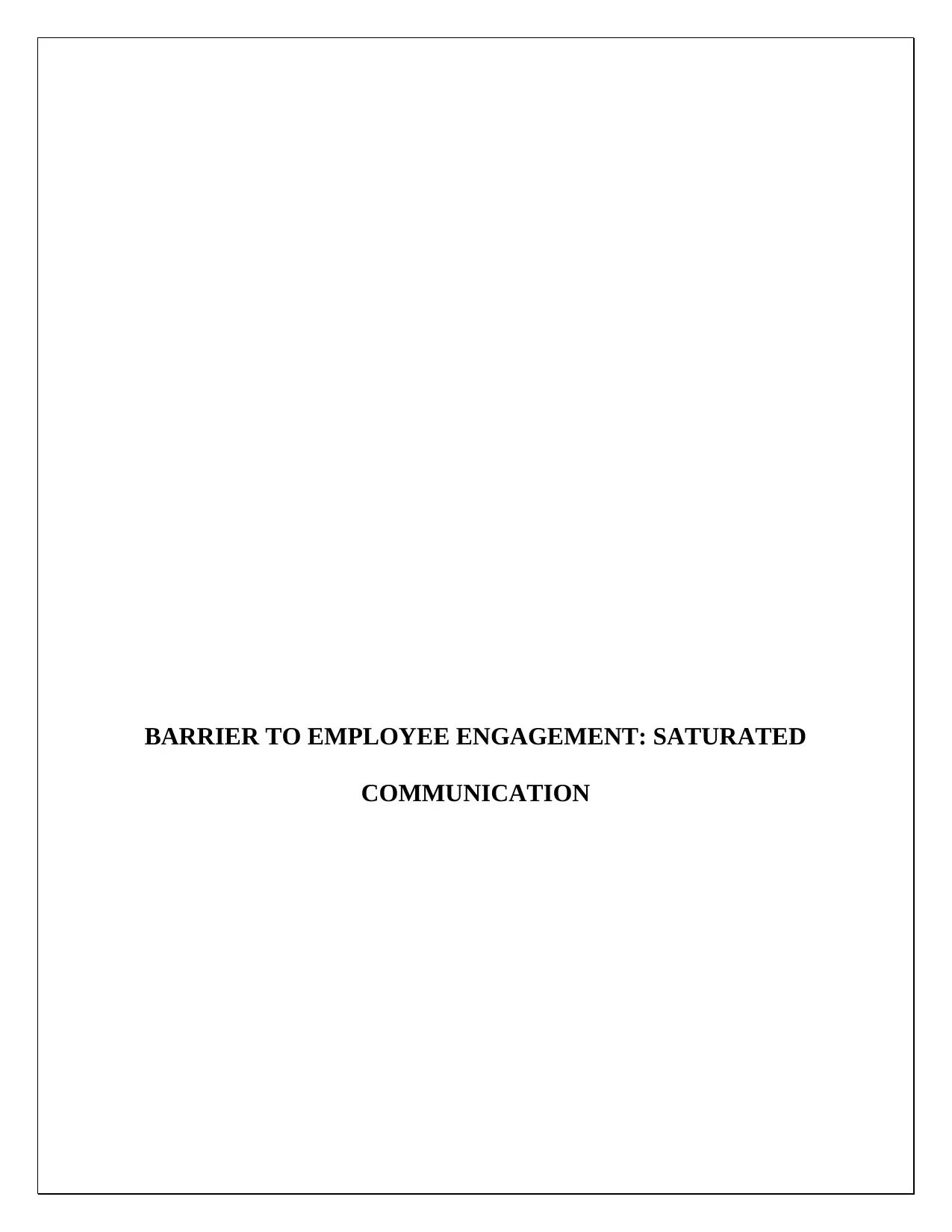
BARRIER TO EMPLOYEE ENGAGEMENT: SATURATED
COMMUNICATION
COMMUNICATION
Paraphrase This Document
Need a fresh take? Get an instant paraphrase of this document with our AI Paraphraser
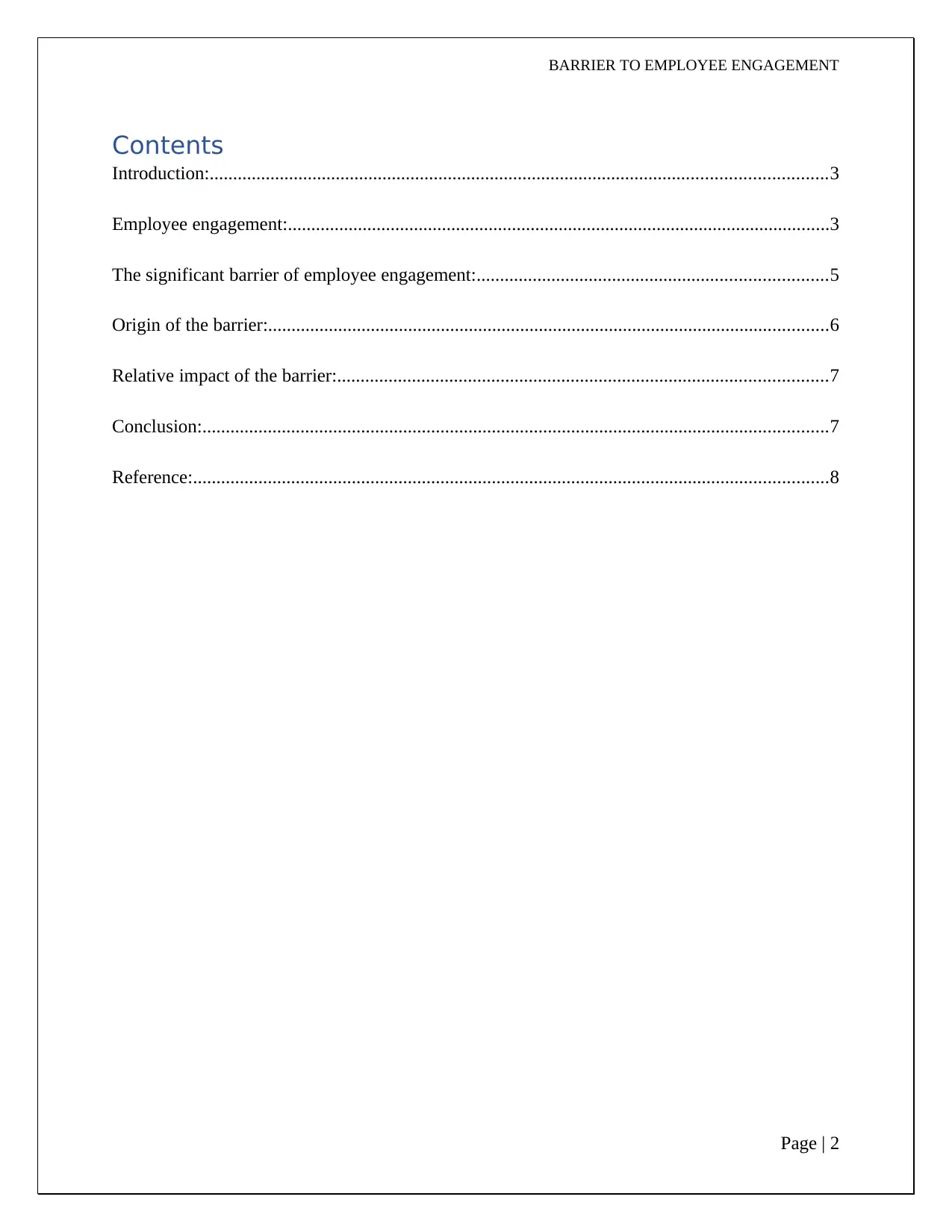
BARRIER TO EMPLOYEE ENGAGEMENT
Contents
Introduction:....................................................................................................................................3
Employee engagement:....................................................................................................................3
The significant barrier of employee engagement:...........................................................................5
Origin of the barrier:........................................................................................................................6
Relative impact of the barrier:.........................................................................................................7
Conclusion:......................................................................................................................................7
Reference:........................................................................................................................................8
Page | 2
Contents
Introduction:....................................................................................................................................3
Employee engagement:....................................................................................................................3
The significant barrier of employee engagement:...........................................................................5
Origin of the barrier:........................................................................................................................6
Relative impact of the barrier:.........................................................................................................7
Conclusion:......................................................................................................................................7
Reference:........................................................................................................................................8
Page | 2
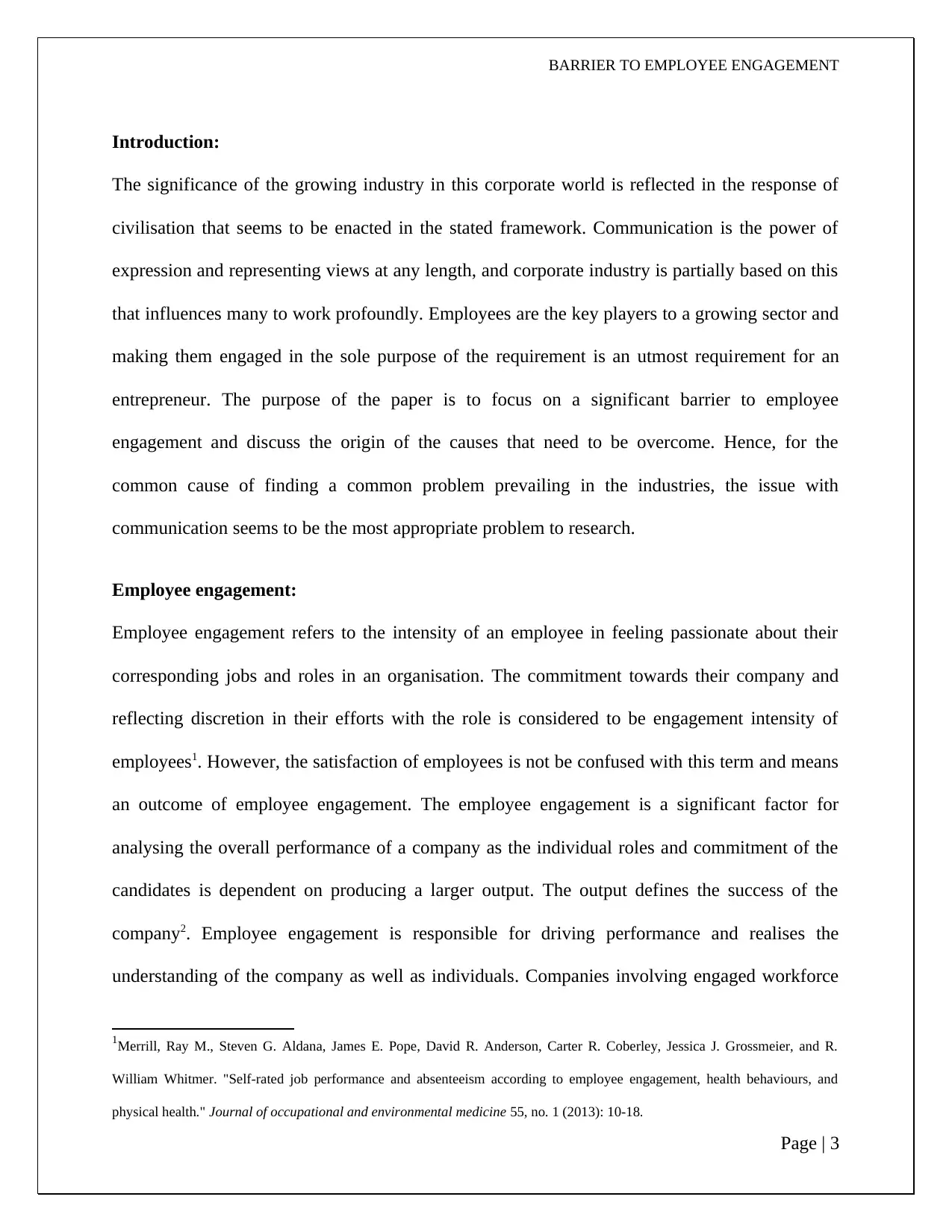
BARRIER TO EMPLOYEE ENGAGEMENT
Introduction:
The significance of the growing industry in this corporate world is reflected in the response of
civilisation that seems to be enacted in the stated framework. Communication is the power of
expression and representing views at any length, and corporate industry is partially based on this
that influences many to work profoundly. Employees are the key players to a growing sector and
making them engaged in the sole purpose of the requirement is an utmost requirement for an
entrepreneur. The purpose of the paper is to focus on a significant barrier to employee
engagement and discuss the origin of the causes that need to be overcome. Hence, for the
common cause of finding a common problem prevailing in the industries, the issue with
communication seems to be the most appropriate problem to research.
Employee engagement:
Employee engagement refers to the intensity of an employee in feeling passionate about their
corresponding jobs and roles in an organisation. The commitment towards their company and
reflecting discretion in their efforts with the role is considered to be engagement intensity of
employees1. However, the satisfaction of employees is not be confused with this term and means
an outcome of employee engagement. The employee engagement is a significant factor for
analysing the overall performance of a company as the individual roles and commitment of the
candidates is dependent on producing a larger output. The output defines the success of the
company2. Employee engagement is responsible for driving performance and realises the
understanding of the company as well as individuals. Companies involving engaged workforce
1Merrill, Ray M., Steven G. Aldana, James E. Pope, David R. Anderson, Carter R. Coberley, Jessica J. Grossmeier, and R.
William Whitmer. "Self-rated job performance and absenteeism according to employee engagement, health behaviours, and
physical health." Journal of occupational and environmental medicine 55, no. 1 (2013): 10-18.
Page | 3
Introduction:
The significance of the growing industry in this corporate world is reflected in the response of
civilisation that seems to be enacted in the stated framework. Communication is the power of
expression and representing views at any length, and corporate industry is partially based on this
that influences many to work profoundly. Employees are the key players to a growing sector and
making them engaged in the sole purpose of the requirement is an utmost requirement for an
entrepreneur. The purpose of the paper is to focus on a significant barrier to employee
engagement and discuss the origin of the causes that need to be overcome. Hence, for the
common cause of finding a common problem prevailing in the industries, the issue with
communication seems to be the most appropriate problem to research.
Employee engagement:
Employee engagement refers to the intensity of an employee in feeling passionate about their
corresponding jobs and roles in an organisation. The commitment towards their company and
reflecting discretion in their efforts with the role is considered to be engagement intensity of
employees1. However, the satisfaction of employees is not be confused with this term and means
an outcome of employee engagement. The employee engagement is a significant factor for
analysing the overall performance of a company as the individual roles and commitment of the
candidates is dependent on producing a larger output. The output defines the success of the
company2. Employee engagement is responsible for driving performance and realises the
understanding of the company as well as individuals. Companies involving engaged workforce
1Merrill, Ray M., Steven G. Aldana, James E. Pope, David R. Anderson, Carter R. Coberley, Jessica J. Grossmeier, and R.
William Whitmer. "Self-rated job performance and absenteeism according to employee engagement, health behaviours, and
physical health." Journal of occupational and environmental medicine 55, no. 1 (2013): 10-18.
Page | 3
⊘ This is a preview!⊘
Do you want full access?
Subscribe today to unlock all pages.

Trusted by 1+ million students worldwide
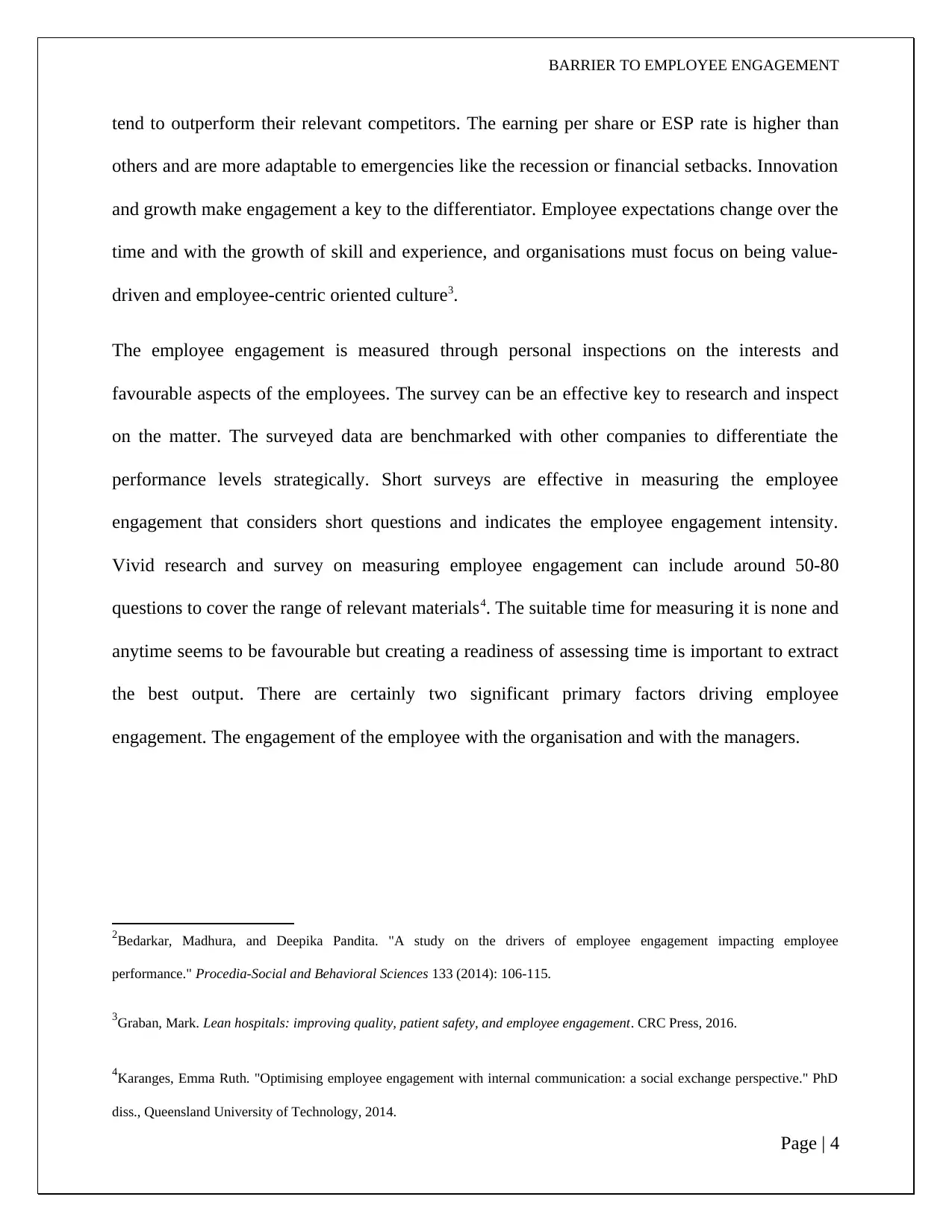
BARRIER TO EMPLOYEE ENGAGEMENT
tend to outperform their relevant competitors. The earning per share or ESP rate is higher than
others and are more adaptable to emergencies like the recession or financial setbacks. Innovation
and growth make engagement a key to the differentiator. Employee expectations change over the
time and with the growth of skill and experience, and organisations must focus on being value-
driven and employee-centric oriented culture3.
The employee engagement is measured through personal inspections on the interests and
favourable aspects of the employees. The survey can be an effective key to research and inspect
on the matter. The surveyed data are benchmarked with other companies to differentiate the
performance levels strategically. Short surveys are effective in measuring the employee
engagement that considers short questions and indicates the employee engagement intensity.
Vivid research and survey on measuring employee engagement can include around 50-80
questions to cover the range of relevant materials4. The suitable time for measuring it is none and
anytime seems to be favourable but creating a readiness of assessing time is important to extract
the best output. There are certainly two significant primary factors driving employee
engagement. The engagement of the employee with the organisation and with the managers.
2Bedarkar, Madhura, and Deepika Pandita. "A study on the drivers of employee engagement impacting employee
performance." Procedia-Social and Behavioral Sciences 133 (2014): 106-115.
3Graban, Mark. Lean hospitals: improving quality, patient safety, and employee engagement. CRC Press, 2016.
4Karanges, Emma Ruth. "Optimising employee engagement with internal communication: a social exchange perspective." PhD
diss., Queensland University of Technology, 2014.
Page | 4
tend to outperform their relevant competitors. The earning per share or ESP rate is higher than
others and are more adaptable to emergencies like the recession or financial setbacks. Innovation
and growth make engagement a key to the differentiator. Employee expectations change over the
time and with the growth of skill and experience, and organisations must focus on being value-
driven and employee-centric oriented culture3.
The employee engagement is measured through personal inspections on the interests and
favourable aspects of the employees. The survey can be an effective key to research and inspect
on the matter. The surveyed data are benchmarked with other companies to differentiate the
performance levels strategically. Short surveys are effective in measuring the employee
engagement that considers short questions and indicates the employee engagement intensity.
Vivid research and survey on measuring employee engagement can include around 50-80
questions to cover the range of relevant materials4. The suitable time for measuring it is none and
anytime seems to be favourable but creating a readiness of assessing time is important to extract
the best output. There are certainly two significant primary factors driving employee
engagement. The engagement of the employee with the organisation and with the managers.
2Bedarkar, Madhura, and Deepika Pandita. "A study on the drivers of employee engagement impacting employee
performance." Procedia-Social and Behavioral Sciences 133 (2014): 106-115.
3Graban, Mark. Lean hospitals: improving quality, patient safety, and employee engagement. CRC Press, 2016.
4Karanges, Emma Ruth. "Optimising employee engagement with internal communication: a social exchange perspective." PhD
diss., Queensland University of Technology, 2014.
Page | 4
Paraphrase This Document
Need a fresh take? Get an instant paraphrase of this document with our AI Paraphraser
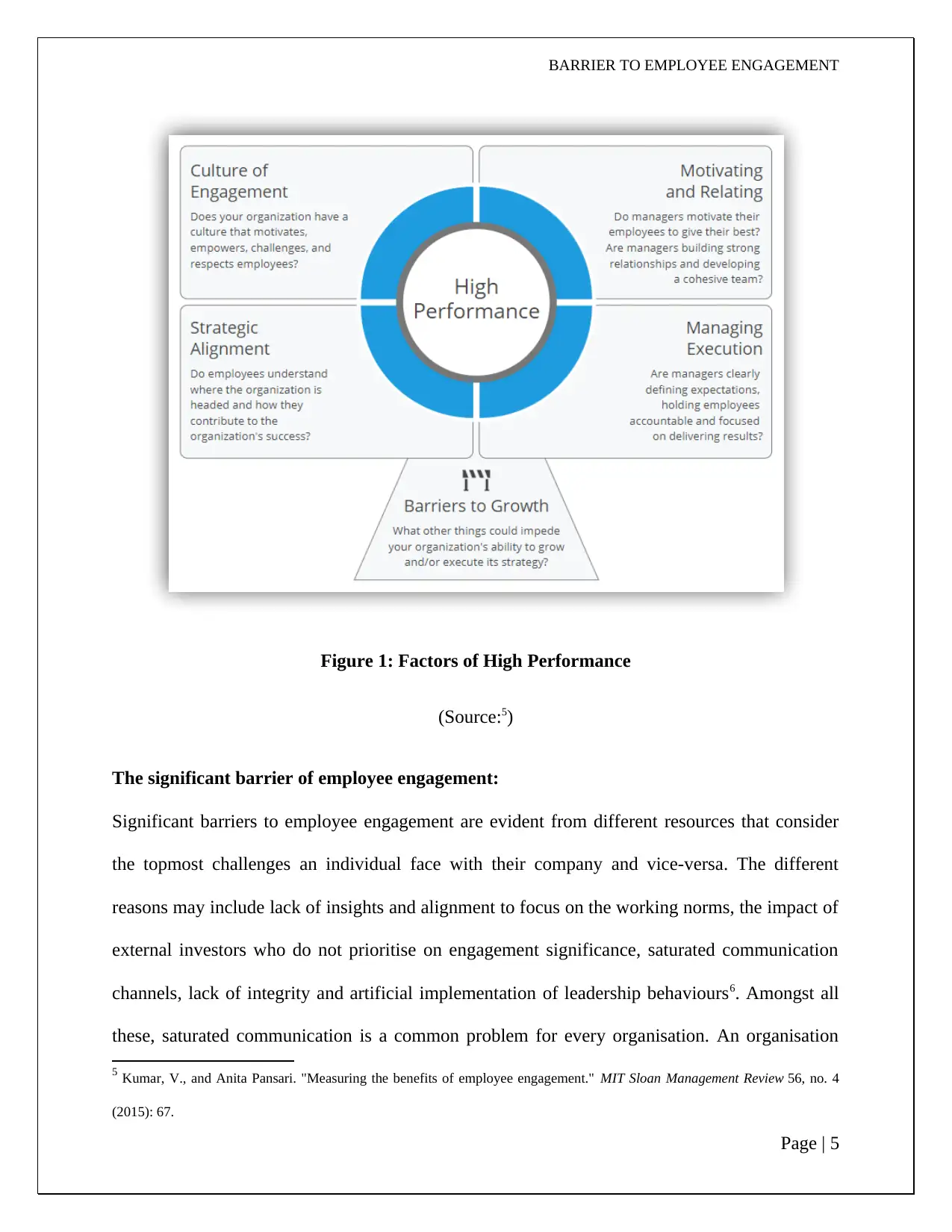
BARRIER TO EMPLOYEE ENGAGEMENT
Figure 1: Factors of High Performance
(Source:5)
The significant barrier of employee engagement:
Significant barriers to employee engagement are evident from different resources that consider
the topmost challenges an individual face with their company and vice-versa. The different
reasons may include lack of insights and alignment to focus on the working norms, the impact of
external investors who do not prioritise on engagement significance, saturated communication
channels, lack of integrity and artificial implementation of leadership behaviours6. Amongst all
these, saturated communication is a common problem for every organisation. An organisation
5 Kumar, V., and Anita Pansari. "Measuring the benefits of employee engagement." MIT Sloan Management Review 56, no. 4
(2015): 67.
Page | 5
Figure 1: Factors of High Performance
(Source:5)
The significant barrier of employee engagement:
Significant barriers to employee engagement are evident from different resources that consider
the topmost challenges an individual face with their company and vice-versa. The different
reasons may include lack of insights and alignment to focus on the working norms, the impact of
external investors who do not prioritise on engagement significance, saturated communication
channels, lack of integrity and artificial implementation of leadership behaviours6. Amongst all
these, saturated communication is a common problem for every organisation. An organisation
5 Kumar, V., and Anita Pansari. "Measuring the benefits of employee engagement." MIT Sloan Management Review 56, no. 4
(2015): 67.
Page | 5
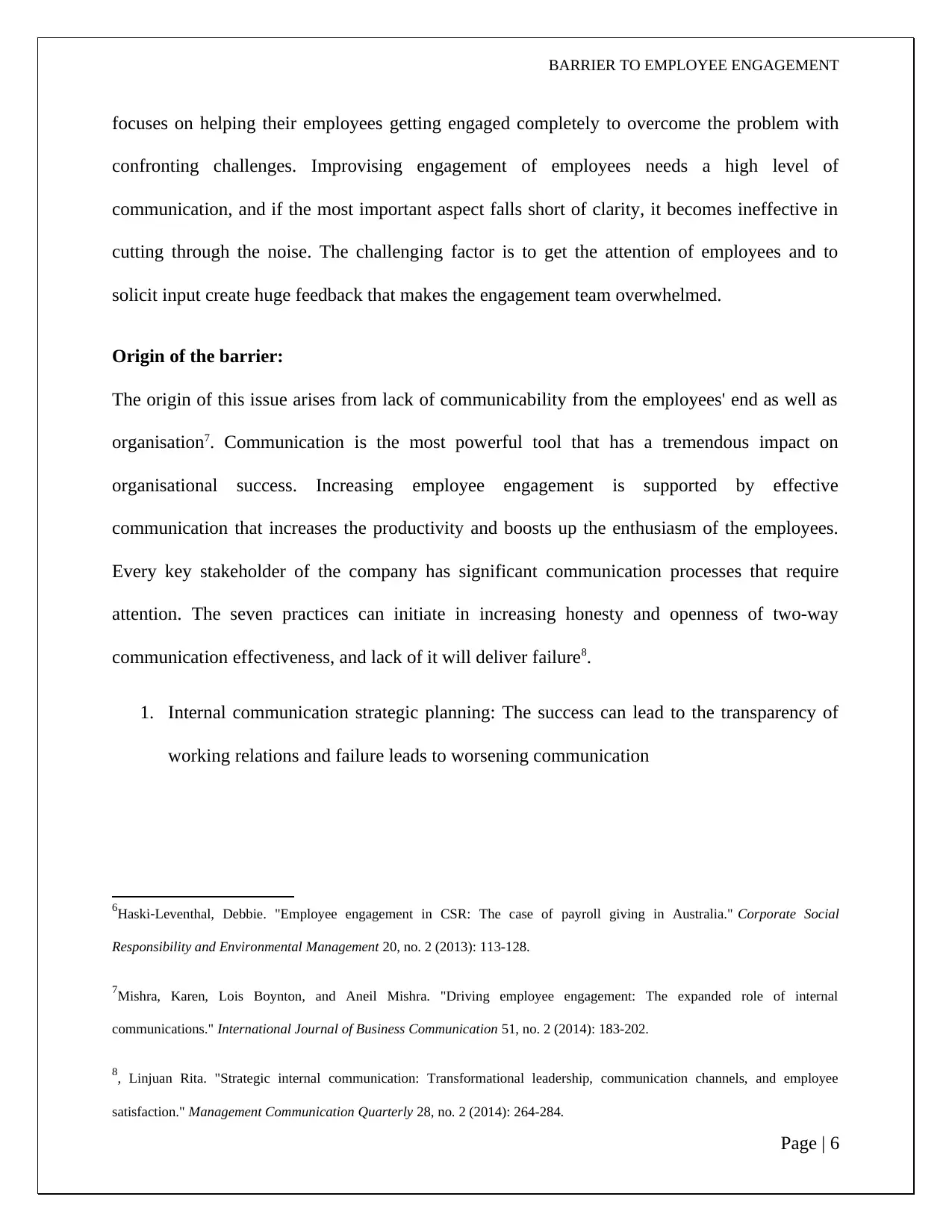
BARRIER TO EMPLOYEE ENGAGEMENT
focuses on helping their employees getting engaged completely to overcome the problem with
confronting challenges. Improvising engagement of employees needs a high level of
communication, and if the most important aspect falls short of clarity, it becomes ineffective in
cutting through the noise. The challenging factor is to get the attention of employees and to
solicit input create huge feedback that makes the engagement team overwhelmed.
Origin of the barrier:
The origin of this issue arises from lack of communicability from the employees' end as well as
organisation7. Communication is the most powerful tool that has a tremendous impact on
organisational success. Increasing employee engagement is supported by effective
communication that increases the productivity and boosts up the enthusiasm of the employees.
Every key stakeholder of the company has significant communication processes that require
attention. The seven practices can initiate in increasing honesty and openness of two-way
communication effectiveness, and lack of it will deliver failure8.
1. Internal communication strategic planning: The success can lead to the transparency of
working relations and failure leads to worsening communication
6Haski‐Leventhal, Debbie. "Employee engagement in CSR: The case of payroll giving in Australia." Corporate Social
Responsibility and Environmental Management 20, no. 2 (2013): 113-128.
7Mishra, Karen, Lois Boynton, and Aneil Mishra. "Driving employee engagement: The expanded role of internal
communications." International Journal of Business Communication 51, no. 2 (2014): 183-202.
8, Linjuan Rita. "Strategic internal communication: Transformational leadership, communication channels, and employee
satisfaction." Management Communication Quarterly 28, no. 2 (2014): 264-284.
Page | 6
focuses on helping their employees getting engaged completely to overcome the problem with
confronting challenges. Improvising engagement of employees needs a high level of
communication, and if the most important aspect falls short of clarity, it becomes ineffective in
cutting through the noise. The challenging factor is to get the attention of employees and to
solicit input create huge feedback that makes the engagement team overwhelmed.
Origin of the barrier:
The origin of this issue arises from lack of communicability from the employees' end as well as
organisation7. Communication is the most powerful tool that has a tremendous impact on
organisational success. Increasing employee engagement is supported by effective
communication that increases the productivity and boosts up the enthusiasm of the employees.
Every key stakeholder of the company has significant communication processes that require
attention. The seven practices can initiate in increasing honesty and openness of two-way
communication effectiveness, and lack of it will deliver failure8.
1. Internal communication strategic planning: The success can lead to the transparency of
working relations and failure leads to worsening communication
6Haski‐Leventhal, Debbie. "Employee engagement in CSR: The case of payroll giving in Australia." Corporate Social
Responsibility and Environmental Management 20, no. 2 (2013): 113-128.
7Mishra, Karen, Lois Boynton, and Aneil Mishra. "Driving employee engagement: The expanded role of internal
communications." International Journal of Business Communication 51, no. 2 (2014): 183-202.
8, Linjuan Rita. "Strategic internal communication: Transformational leadership, communication channels, and employee
satisfaction." Management Communication Quarterly 28, no. 2 (2014): 264-284.
Page | 6
⊘ This is a preview!⊘
Do you want full access?
Subscribe today to unlock all pages.

Trusted by 1+ million students worldwide
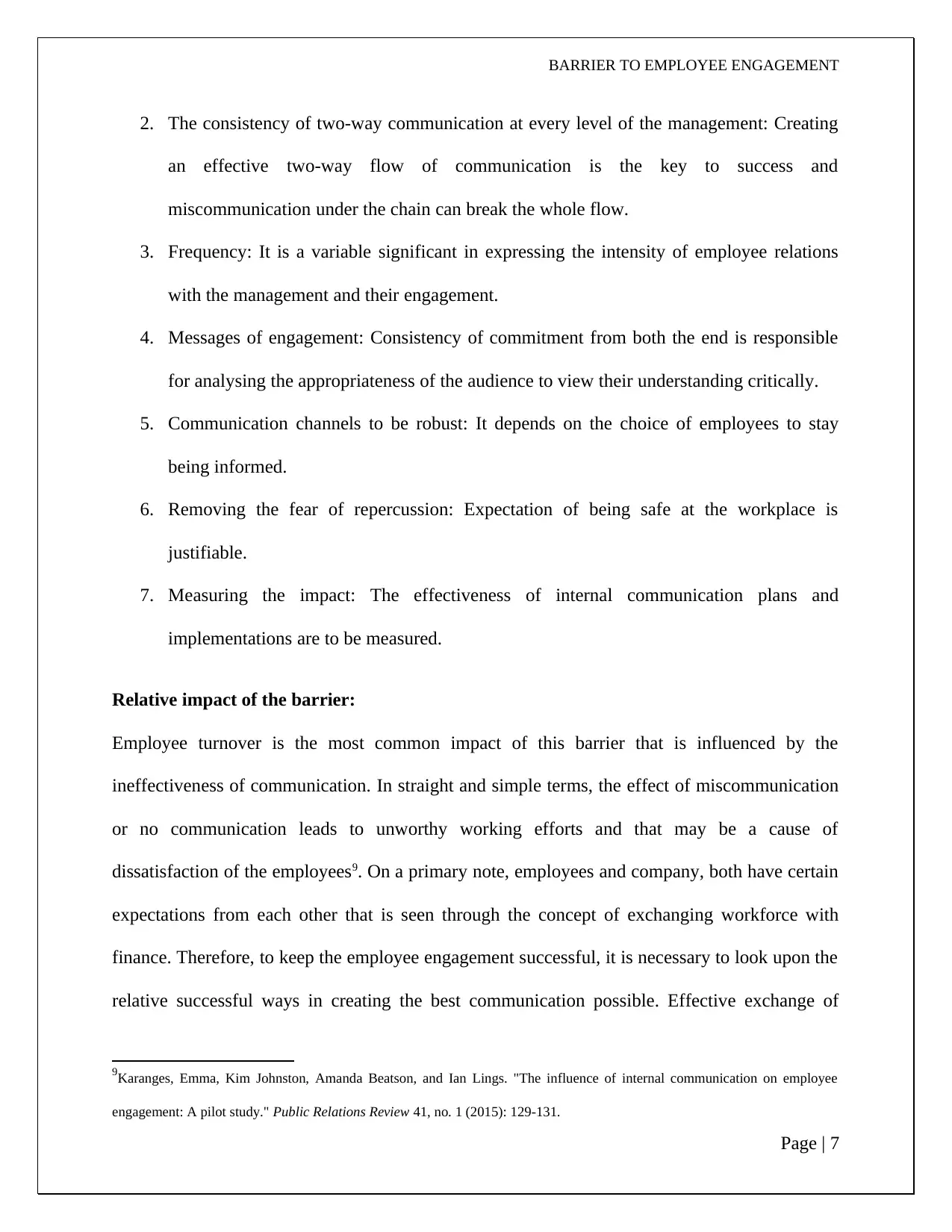
BARRIER TO EMPLOYEE ENGAGEMENT
2. The consistency of two-way communication at every level of the management: Creating
an effective two-way flow of communication is the key to success and
miscommunication under the chain can break the whole flow.
3. Frequency: It is a variable significant in expressing the intensity of employee relations
with the management and their engagement.
4. Messages of engagement: Consistency of commitment from both the end is responsible
for analysing the appropriateness of the audience to view their understanding critically.
5. Communication channels to be robust: It depends on the choice of employees to stay
being informed.
6. Removing the fear of repercussion: Expectation of being safe at the workplace is
justifiable.
7. Measuring the impact: The effectiveness of internal communication plans and
implementations are to be measured.
Relative impact of the barrier:
Employee turnover is the most common impact of this barrier that is influenced by the
ineffectiveness of communication. In straight and simple terms, the effect of miscommunication
or no communication leads to unworthy working efforts and that may be a cause of
dissatisfaction of the employees9. On a primary note, employees and company, both have certain
expectations from each other that is seen through the concept of exchanging workforce with
finance. Therefore, to keep the employee engagement successful, it is necessary to look upon the
relative successful ways in creating the best communication possible. Effective exchange of
9Karanges, Emma, Kim Johnston, Amanda Beatson, and Ian Lings. "The influence of internal communication on employee
engagement: A pilot study." Public Relations Review 41, no. 1 (2015): 129-131.
Page | 7
2. The consistency of two-way communication at every level of the management: Creating
an effective two-way flow of communication is the key to success and
miscommunication under the chain can break the whole flow.
3. Frequency: It is a variable significant in expressing the intensity of employee relations
with the management and their engagement.
4. Messages of engagement: Consistency of commitment from both the end is responsible
for analysing the appropriateness of the audience to view their understanding critically.
5. Communication channels to be robust: It depends on the choice of employees to stay
being informed.
6. Removing the fear of repercussion: Expectation of being safe at the workplace is
justifiable.
7. Measuring the impact: The effectiveness of internal communication plans and
implementations are to be measured.
Relative impact of the barrier:
Employee turnover is the most common impact of this barrier that is influenced by the
ineffectiveness of communication. In straight and simple terms, the effect of miscommunication
or no communication leads to unworthy working efforts and that may be a cause of
dissatisfaction of the employees9. On a primary note, employees and company, both have certain
expectations from each other that is seen through the concept of exchanging workforce with
finance. Therefore, to keep the employee engagement successful, it is necessary to look upon the
relative successful ways in creating the best communication possible. Effective exchange of
9Karanges, Emma, Kim Johnston, Amanda Beatson, and Ian Lings. "The influence of internal communication on employee
engagement: A pilot study." Public Relations Review 41, no. 1 (2015): 129-131.
Page | 7
Paraphrase This Document
Need a fresh take? Get an instant paraphrase of this document with our AI Paraphraser
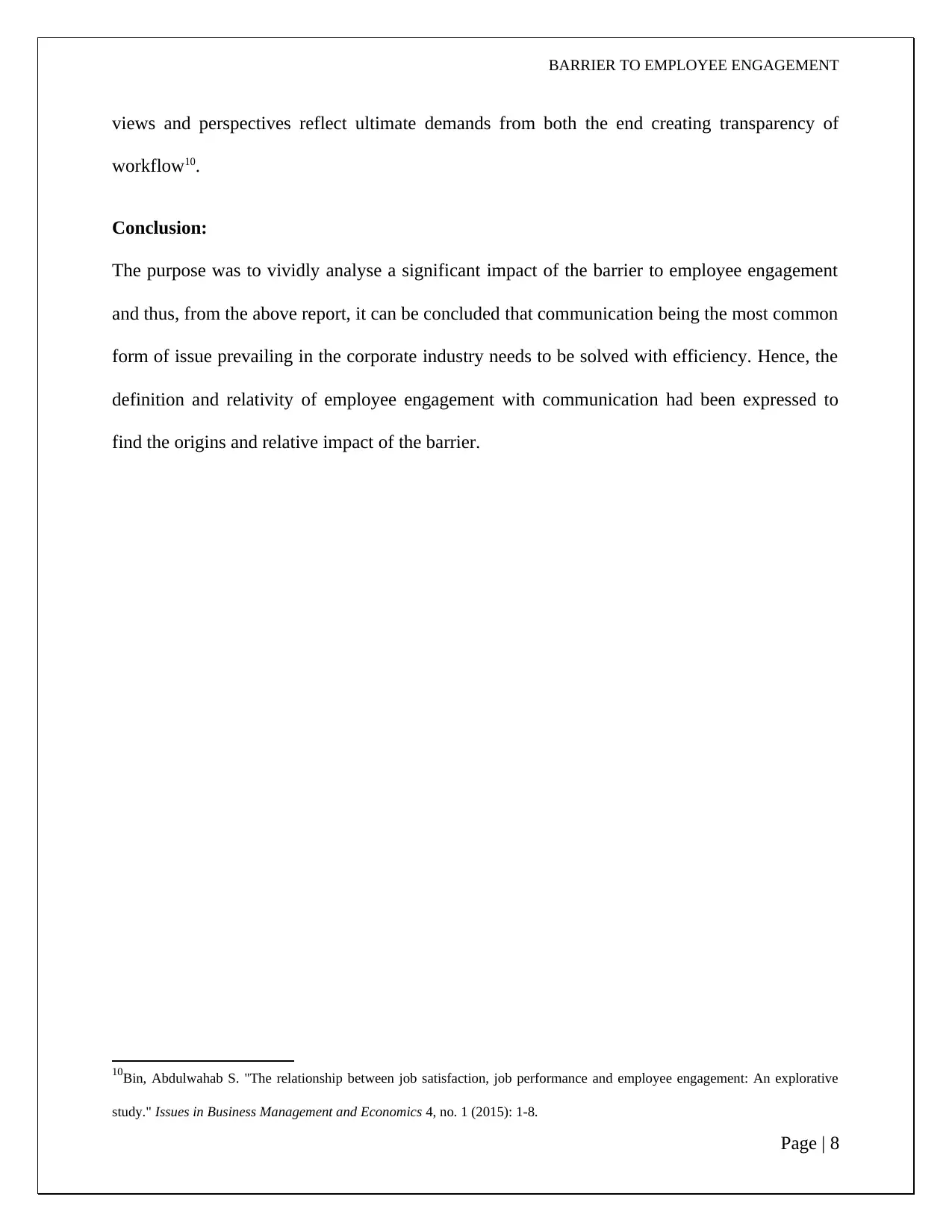
BARRIER TO EMPLOYEE ENGAGEMENT
views and perspectives reflect ultimate demands from both the end creating transparency of
workflow10.
Conclusion:
The purpose was to vividly analyse a significant impact of the barrier to employee engagement
and thus, from the above report, it can be concluded that communication being the most common
form of issue prevailing in the corporate industry needs to be solved with efficiency. Hence, the
definition and relativity of employee engagement with communication had been expressed to
find the origins and relative impact of the barrier.
10Bin, Abdulwahab S. "The relationship between job satisfaction, job performance and employee engagement: An explorative
study." Issues in Business Management and Economics 4, no. 1 (2015): 1-8.
Page | 8
views and perspectives reflect ultimate demands from both the end creating transparency of
workflow10.
Conclusion:
The purpose was to vividly analyse a significant impact of the barrier to employee engagement
and thus, from the above report, it can be concluded that communication being the most common
form of issue prevailing in the corporate industry needs to be solved with efficiency. Hence, the
definition and relativity of employee engagement with communication had been expressed to
find the origins and relative impact of the barrier.
10Bin, Abdulwahab S. "The relationship between job satisfaction, job performance and employee engagement: An explorative
study." Issues in Business Management and Economics 4, no. 1 (2015): 1-8.
Page | 8
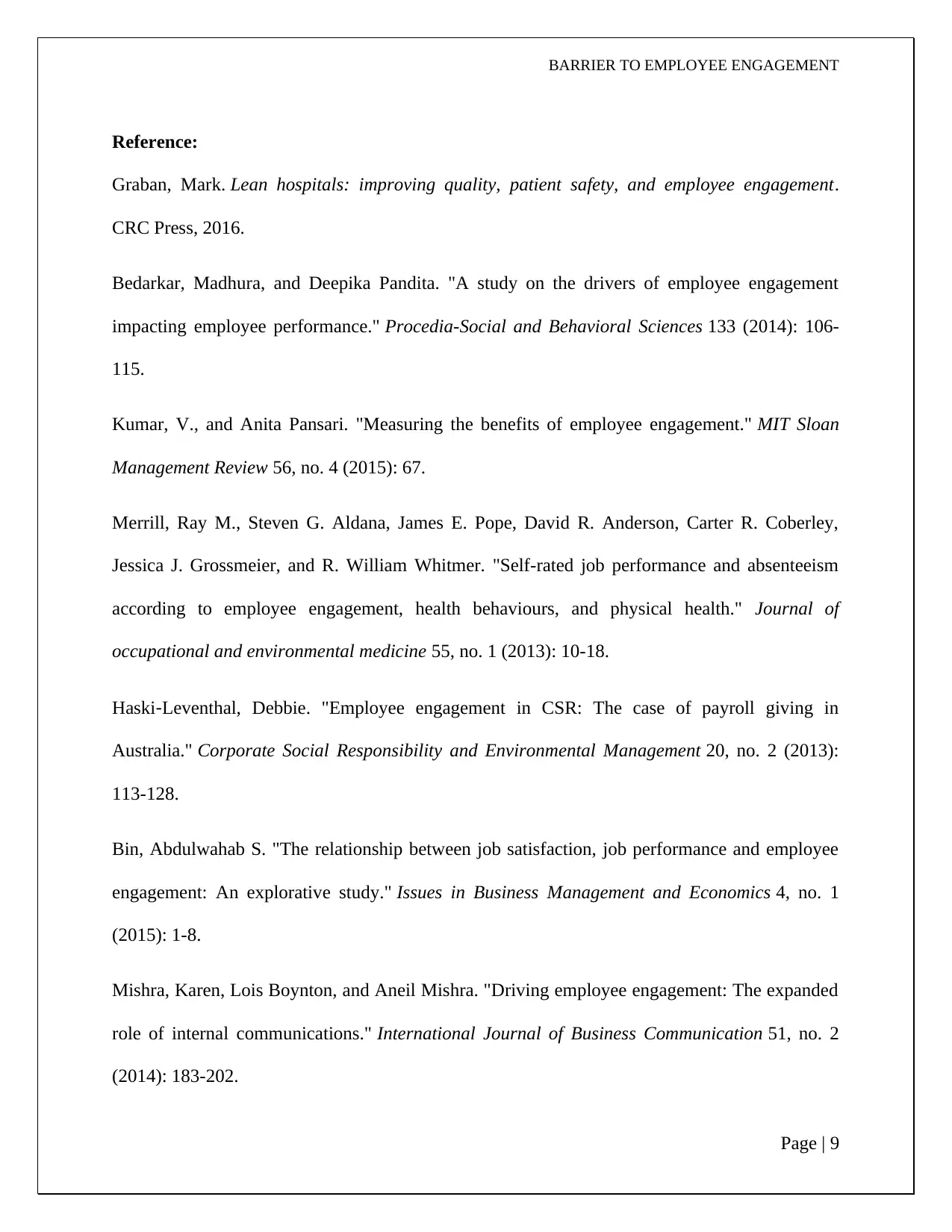
BARRIER TO EMPLOYEE ENGAGEMENT
Reference:
Graban, Mark. Lean hospitals: improving quality, patient safety, and employee engagement.
CRC Press, 2016.
Bedarkar, Madhura, and Deepika Pandita. "A study on the drivers of employee engagement
impacting employee performance." Procedia-Social and Behavioral Sciences 133 (2014): 106-
115.
Kumar, V., and Anita Pansari. "Measuring the benefits of employee engagement." MIT Sloan
Management Review 56, no. 4 (2015): 67.
Merrill, Ray M., Steven G. Aldana, James E. Pope, David R. Anderson, Carter R. Coberley,
Jessica J. Grossmeier, and R. William Whitmer. "Self-rated job performance and absenteeism
according to employee engagement, health behaviours, and physical health." Journal of
occupational and environmental medicine 55, no. 1 (2013): 10-18.
Haski‐Leventhal, Debbie. "Employee engagement in CSR: The case of payroll giving in
Australia." Corporate Social Responsibility and Environmental Management 20, no. 2 (2013):
113-128.
Bin, Abdulwahab S. "The relationship between job satisfaction, job performance and employee
engagement: An explorative study." Issues in Business Management and Economics 4, no. 1
(2015): 1-8.
Mishra, Karen, Lois Boynton, and Aneil Mishra. "Driving employee engagement: The expanded
role of internal communications." International Journal of Business Communication 51, no. 2
(2014): 183-202.
Page | 9
Reference:
Graban, Mark. Lean hospitals: improving quality, patient safety, and employee engagement.
CRC Press, 2016.
Bedarkar, Madhura, and Deepika Pandita. "A study on the drivers of employee engagement
impacting employee performance." Procedia-Social and Behavioral Sciences 133 (2014): 106-
115.
Kumar, V., and Anita Pansari. "Measuring the benefits of employee engagement." MIT Sloan
Management Review 56, no. 4 (2015): 67.
Merrill, Ray M., Steven G. Aldana, James E. Pope, David R. Anderson, Carter R. Coberley,
Jessica J. Grossmeier, and R. William Whitmer. "Self-rated job performance and absenteeism
according to employee engagement, health behaviours, and physical health." Journal of
occupational and environmental medicine 55, no. 1 (2013): 10-18.
Haski‐Leventhal, Debbie. "Employee engagement in CSR: The case of payroll giving in
Australia." Corporate Social Responsibility and Environmental Management 20, no. 2 (2013):
113-128.
Bin, Abdulwahab S. "The relationship between job satisfaction, job performance and employee
engagement: An explorative study." Issues in Business Management and Economics 4, no. 1
(2015): 1-8.
Mishra, Karen, Lois Boynton, and Aneil Mishra. "Driving employee engagement: The expanded
role of internal communications." International Journal of Business Communication 51, no. 2
(2014): 183-202.
Page | 9
⊘ This is a preview!⊘
Do you want full access?
Subscribe today to unlock all pages.

Trusted by 1+ million students worldwide
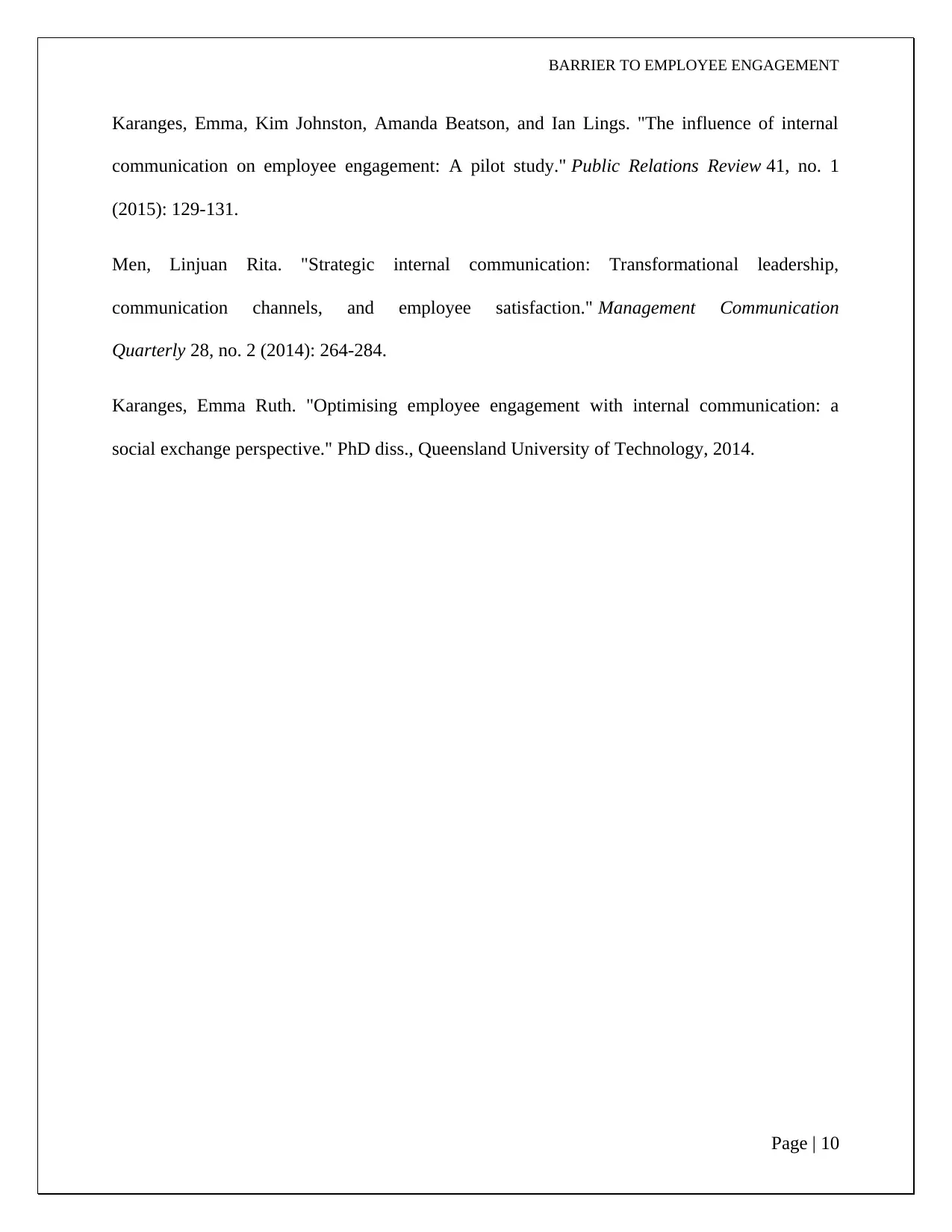
BARRIER TO EMPLOYEE ENGAGEMENT
Karanges, Emma, Kim Johnston, Amanda Beatson, and Ian Lings. "The influence of internal
communication on employee engagement: A pilot study." Public Relations Review 41, no. 1
(2015): 129-131.
Men, Linjuan Rita. "Strategic internal communication: Transformational leadership,
communication channels, and employee satisfaction." Management Communication
Quarterly 28, no. 2 (2014): 264-284.
Karanges, Emma Ruth. "Optimising employee engagement with internal communication: a
social exchange perspective." PhD diss., Queensland University of Technology, 2014.
Page | 10
Karanges, Emma, Kim Johnston, Amanda Beatson, and Ian Lings. "The influence of internal
communication on employee engagement: A pilot study." Public Relations Review 41, no. 1
(2015): 129-131.
Men, Linjuan Rita. "Strategic internal communication: Transformational leadership,
communication channels, and employee satisfaction." Management Communication
Quarterly 28, no. 2 (2014): 264-284.
Karanges, Emma Ruth. "Optimising employee engagement with internal communication: a
social exchange perspective." PhD diss., Queensland University of Technology, 2014.
Page | 10
1 out of 10
Related Documents
Your All-in-One AI-Powered Toolkit for Academic Success.
+13062052269
info@desklib.com
Available 24*7 on WhatsApp / Email
![[object Object]](/_next/static/media/star-bottom.7253800d.svg)
Unlock your academic potential
Copyright © 2020–2025 A2Z Services. All Rights Reserved. Developed and managed by ZUCOL.





